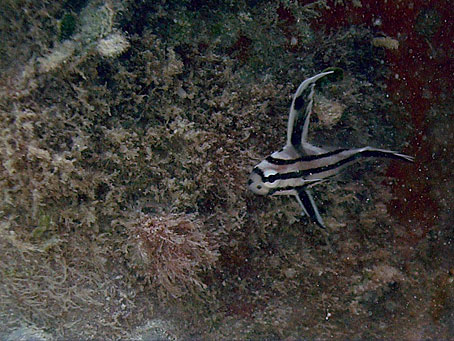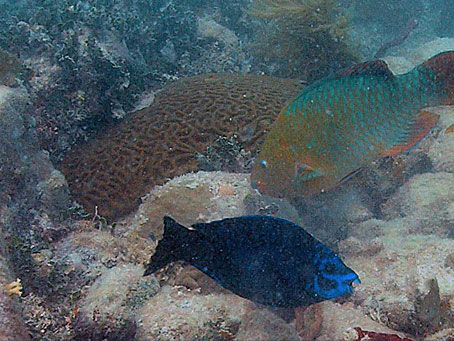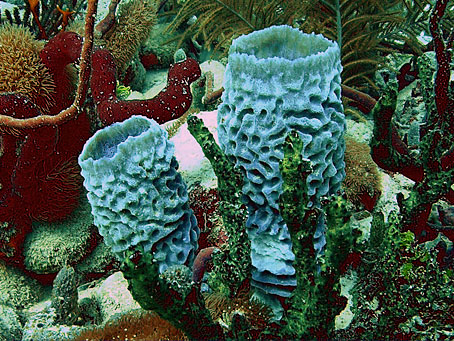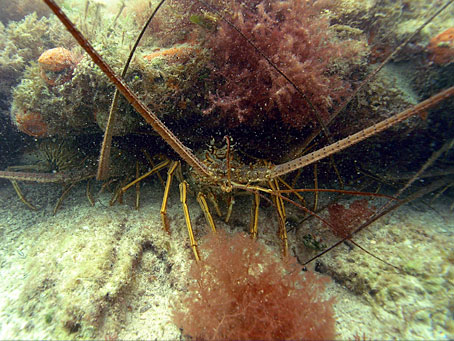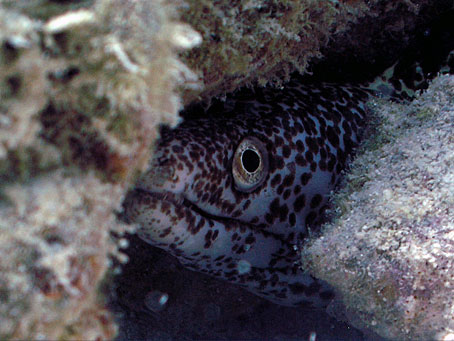Copenhagen Biology from Florida DHR on Vimeo.
Click the play button above to view a montage of the rich variety of marine life found near the wreckage of SS Copenhagen.
This video contains images of the following marine life: Sergeant Majors, Spotted Goatfish, Grunts, Caribbean Spiny Lobsters, Wrasses, Porgies, Angelfish, Red Snapper, Yellowtail Snapper, Doctorfish, Seafans, and Sea Rods. This video presents a fraction of the diverse marine life that calls SS Copenhagen home.
Click the thumbnails below to view larger images of the various marine life located at the wreckage of SS Copenhagen.
Anemone – Anemones can come in multiple colors and either living in a colony or alone. The body of an Anemone looks like a bouquet of tentacles with slightly enlarged tips that may be a slightly different color from the body of the tentacle. The anemone is not considered toxic to the human touch but it may sting a little or irritate the skin if you brush up against it.
bio1.jpg
Anemone
Angelfish – Angelfish come in a variety of colors, from grey and yellow to green, blue, and yellow, to black and yellow, banded, and plain. One identifiable feature of angelfish are the square pectoral fin. Angelfish often swim around the reefs in pairs, so if you see one, look for its mate.
bio2.jpg
Angelfish
Cleaner shrimp – These small animals have transparent bodies and legs covered with blue/purple bands or spots. They also have two pairs or long white antennae. You will often find them living in an anemone. When they sway their white antennae they are trying to attract fish.
bio3.jpg
Cleaner shrimp
Feather duster – these creatures come in a variety of colors, ranging from brown, to orange, to red, and violet. Many times, Feather dusters have bands or spots of different colors. They also grow in clusters.
bio4.jpg
Feather duster
Grunts – The common family name, Grunt, comes from the sound the fish make when they grind their teeth together which becomes amplified by their air bladder. Most of the fish in the Grunt family are colorful, and drift in schools throughout the shallow reefs during the day and feed at night.
bio5.jpg
Grunts
Blue Tang – similar to Doctorfish, the Blue Tang can change from blueish gray to dark brown as an adult and be bright yellow as a juvenile. They will be found on reefs and are often seen head down eating algae.
bio6.jpg
Blue Tang
Highhat – The juvenile Highhat looks very different from its adult counterpart. The adult black and white striped body, has a much shorter dorsal fin than the juvenile. One key feature of a Highhat is the elongated front dorsal fin. The juvenile Highhat looks very similar to a Jackknife fish.
bio7.jpg
Highhat
Parrotfish – Parrotfishes are named for their teeth which form a parrot-like beak which scrapes algae from coral and other surfaces. These fish are often very colorful, with their bodies ranging from bright shades of blue, green, red and yellow, to a rainbow of color.
bio8.jpg
Parrotfish
Purple Sponge – Sponges are filter feeders. In order to eat, these animals pump water through their bodies to filter out particles of food matter. They also come in a variety of colors and sizes and can be found in a variety of environments, from the shallow intertidal zone down to more than 25,000 feet.
bio9.jpg
Purple Sponge
Caribbean Spiny Lobster – The Caribbean Spiny Lobster can be identified by the shaded areas of brown and tan along the body. The back of the body often has a few dark spots while the abdomen has a few light spots. This type of lobster inhabits the reefs and hides under shipwrecks and other debris in the water.
bio10.jpg
Caribbean Spiny Lobster
Spotted Moray – Spotted Moray eels have speckles of dark brown amongst a creamy white. They are often found in shallow reefs, rocky areas, and under shipwreck debris. Eels often open and close their mouths, do not worry, this isn’t to hurt you, it is an action required for respiration.
bio11.jpg
Spotted Moray






